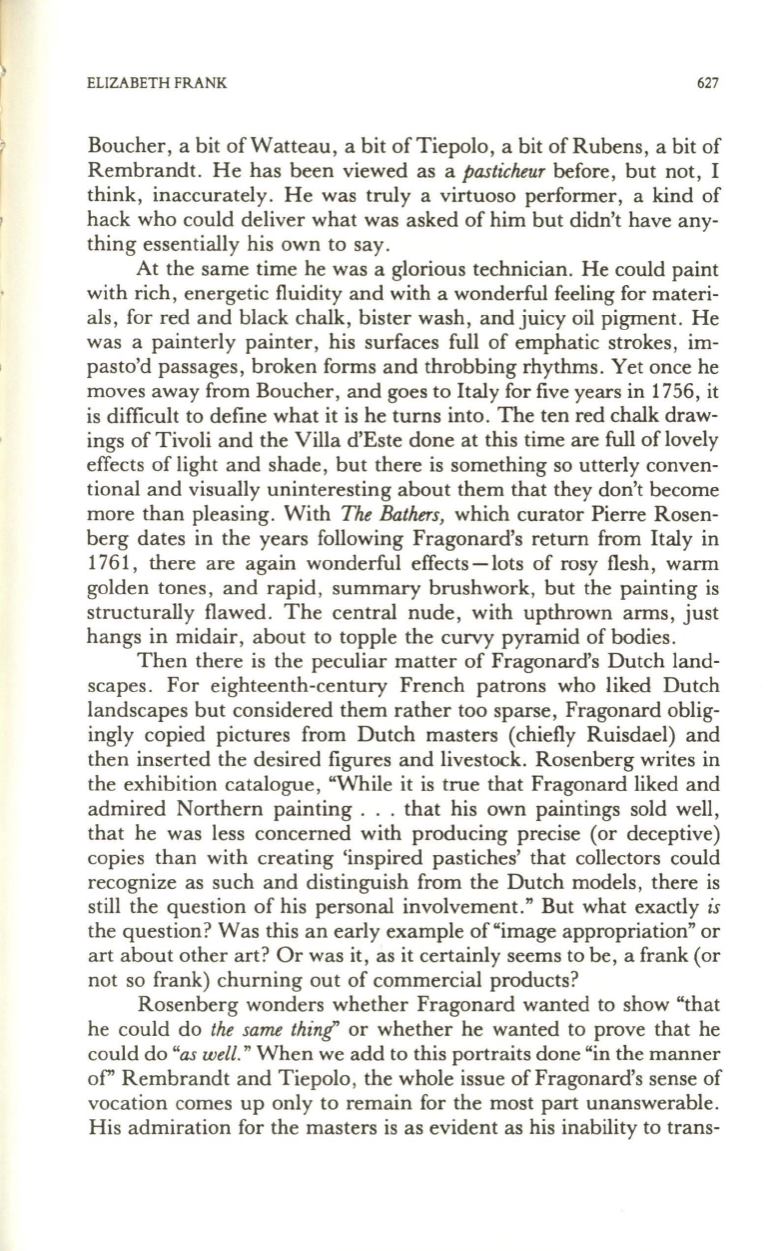
~
ELIZABETH FRANK
627
Boucher, a bit ofWatteau, a bit of Tiepolo, a bit of Rubens, a bit of
Rembrandt. He has been viewed as a
pasticheur
before, but not, I
think, inaccurately . He was truly a virtuoso performer, a kind of
hack who could deliver what was asked of him but didn't have any–
thing essentially his own to say .
At the same time he was a glorious technician. He could paint
with rich, energetic fluidity and with a wonderful feeling for materi–
als, for red and black chalk, bister wash, and juicy oil pigment . He
was a painterly painter, his surfaces full of emphatic strokes, im–
pasto'd passages, broken forms and throbbing rhythms. Yet once he
moves away from Boucher, and goes to Italy for five years in 1756, it
is difficult to define what it is he turns into . The ten red chalk draw–
ings of Tivoli and the Villa d'Este done at this time are full of lovely
effects of light and shade, but there is something so utterly conven–
tional and visually uninteresting about them that they don't become
more than pleasing. With
The Bathers,
which curator Pierre Rosen–
berg dates in the years following Fragonard's return from Italy in
1761, there are again wonderful effects -lots of rosy flesh , warm
golden tones , and rapid, summary brushwork, but the painting is
structurally flawed. The central nude, with upthrown arms, just
hangs in midair, about to topple the curvy pyramid of bodies.
Then there is the peculiar matter of Fragonard's Dutch land–
scapes. For eighteenth-century French patrons who liked Dutch
landscapes but considered them rather too sparse, Fragonard oblig–
ingly copied pictures from Dutch masters (chiefly Ruisdael) and
then inserted the desired figures and livestock. Rosenberg writes in
the exhibition catalogue, "While it is true that Fragonard liked and
admired Northern painting . . . that his own paintings sold well,
that he was less concerned with producing precise (or deceptive)
copies than with creating 'inspired pastiches' that collectors could
recognize as such and distinguish from the Dutch models, there is
still the question of his personal involvement." But what exactly
is
the question? Was this an early example of "image appropriation" or
art about other art? Or was it, as it certainly seems to be, a frank (or
not so frank) churning out of commercial products?
Rosenberg wonders whether Fragonard wanted to show "that
he could do
the same thing'
or whether he wanted to prove that he
could do
"as well.
"
When we add to this portraits done "in the manner
of" Rembrandt and Tiepolo , the whole issue of Fragonard's sense of
vocation comes up only to remain for the most part unanswerable.
His admiration for the masters is as evident as his inability to trans-


